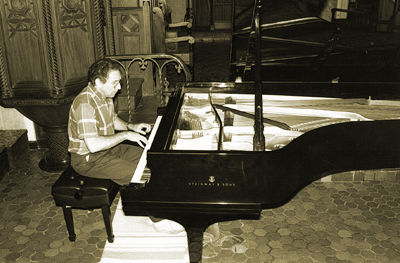| Columns Retired Columns & Blogs |
Stereophile's Test CD 2 Tracks 11-12
Track Information, Tracks 11-12
Footnote 5: The recording of Intermezzo was described in Stereophile, Vol.14 No.2, February 1991. Intermezzo is available on either LP or CD.
[11] Brahms: Intermezzo Op.117 No.1 in E-flat (AAD) 5:24
Robert Silverman, New York Steinway D
[12] Beethoven: "Mozart's Minuet in G" (ADD) 0:44
Robert Silverman, New York Steinway D
Recording Venue: Universalist Unitarian Church, Santa Barbara, CA
Recording Date: January 30, 1990
Recording Engineer: Kavichandran Alexander (Water Lily Acoustics)
Producer: John Atkinson
Analog tape editor: Hugh Davies (Brahms)
Microphones: two EAR The Mics set to figure-8 pattern, coincident at 90 degrees and spaced vertically by 2"
Microphone preamplifier: EAR 824M, Cardas microphone cables
Recorder: Ampex MR70 ½" open-reel recorder at 15ips
Tape: Ampex 456
Transfer to digital: Pygmy AD-1 (Brahms), Manley Analogue to Digital Converter (Beethoven), Panasonic 3700 DAT, Ampex MR-20 open-reel recorder, Cardas Hexlink balanced interconnects
Digital Transfer Engineer: Robert Harley

Robert Silverman at the 9' Steinway, framed by the mike array (see fig.4)
For these piano recording, Kavi Alexander had wanted to capture a bold, powerful piano sound, particularly as the instrument was exciting the church acoustic to a rather excessive degree. The microphone array was placed quite close, about 8' back just below the line of the lid (see photo). The image of the Steinway should therefore be just behind the plane of the speakers, extending from the inside edge of the left-hand speaker, which is where Robert is sitting, to the inside edge of the right (fig.4). The use of a Blumlein technique means that the image should be "solid," though there is a slight pulling to the sides noticeable with loudspeakers possessing sufficient resolving power, due to the slight vertical spacing of the mikes.
Regarding the recording's tonal quality, those used to the typically bright sound of "commercial" piano recordings will find its treble to be a little soft. This accurately represents the true sound of the instrument in the hall at the microphone position, however. The complex manner in which notes decay, their harmonics intertwining, should be readily apparent, while the midrange should be evenly balanced, with no notes "jumping" forward at the listener. In the bass, there should be a strong feeling of weight to low frequencies, low bass notes having some of the quality of a deeply tolling bell.
 | |
| Fig.4 The Universalist Unitarian Church, Santa Barbara, showing positions of the piano, mike array, and LA's path in Track 10 |
The dynamics of the instrument's sound were well captured: in the words of Alfred Brendel, its volume ranges "from a whisper to a roar." Kavi hit the ½" tape hard, reaching 14dB over the 250nWb/m 0VU mark, meaning that tape hiss was nonexistent even without noise reduction. The limiting factor affecting the recording's dynamic range is actually the intrinsic noise of the microphones rather than that of the analog tape; at a realistic playback level—96dB at the most at the listening seat for the very loudest passages—this can be noticed as a soft hiss. Not surprisingly, if you turn up the playback level so that what should be quiet passages become more "impressive," the microphone noise will become intrusive.
Whereas Stereophile's CD release of the three Op.117 Intermezzi, coupled with the Sonata in f, Op.5 (footnote 5) was mastered using the Manley Analogue to Digital Converter, this track was transferred to digital using the Pygmy AD-1, another well-respected unit. RH tried to keep the levels identical with both the A/D converters, so any differences you hear between this track and the same recording on Stereophile's Intermezzo CD will be due to the difference in converters. Remember: "Bits is bits"—or are they?
The first of the three Brahms Op.117 Intermezzi was written in 1892 and is prefaced by the opening couplet of "Lady Anne Bothwell's Lament," an old Scottish ballad:
Schlaf sanft, mein Kind, schlaf sanft und schön!
Mich dauert's sehr, dich weinen sehen.
(Sleep soft, my bairn, now softly sleep!
My heart is wae to see thee weep.)
"Brahms used to call this lovely melody 'the lullaby of my griefs,' " wrote Denis Stevens, "and those who know anything of his life will be well aware of the sorrows he had to bear. Yet this is music to soothe all humanity, and has been capable of doing so ever since it first saw the light."
As a contrast to the Brahms Intermezzo, but again also to set the sound and image of the big Steinway within its acoustic context, we included a bit of fun, recorded during the same sessions, with piano and microphones in the same place. With this lurching exception, due to a music publisher's mental aberration, a minuet is always in ¾ time. Robert provides the appropriate emphasis on every fourth beat, but if you try counting aloud "1-2-3-4," starting on the work's very first note, you'll find that it all works out: "Mozart's Minuet in G," in 4/4 time.
Footnote 5: The recording of Intermezzo was described in Stereophile, Vol.14 No.2, February 1991. Intermezzo is available on either LP or CD.
- Log in or register to post comments




































